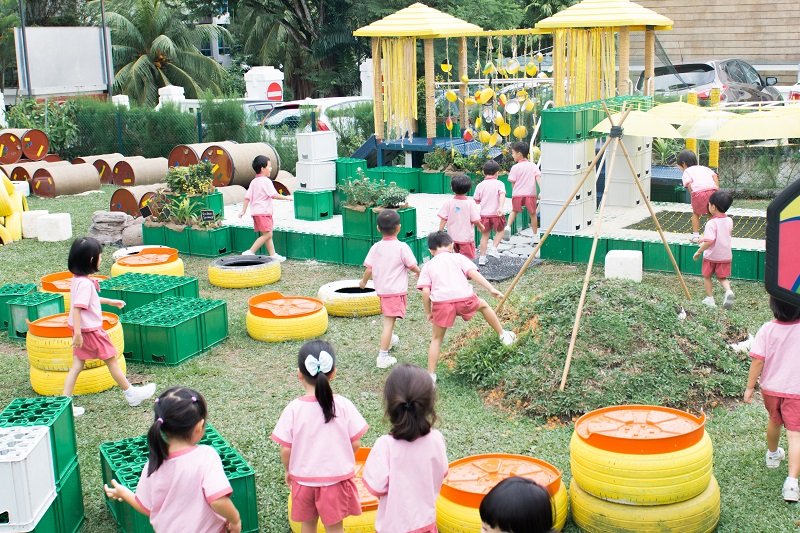In designing Singapore’s first inclusive preschool and other learning spaces, Ar. Ong Ker-Shing and Dr Joshua Comaroff, reflect on what it means to design and create spaces that embrace our diversities and abilities, enabling us to connect, learn and play in many different ways.
In your design of Kindle Garden, how are you breaking down barriers in creating more flexible learning spaces?
Joshua: We’ve learnt that whether you have a specific disability or not, every child has different learning preferences and needs and learns in multi-faceted and non-linear ways.
Some prefer more relaxed and uncomplicated environments. While others prefer for their learning spaces to have more stimulation. To cater for such diverse groups of children, we’ve created many different open spaces and options where the kids can choose to move furniture around, influencing and shaping their classroom spaces and yet still learn in the same space together.

At Kindle Garden, the bubbles in various sizes offer kids flexibility and options to play with. These are also helpful for those with spinal issues, where they can stretch backwards to mobilise their spines. Image: Darren Soh.
We’ve noticed that many of the seats in the classrooms are designed like logs. Why did you create such unusual seats?
Such therapeutic tools or medical equipment typically look quite sterile and clinical. This could make those students who need to use them feel discriminated against. So, we deliberately redesigned all such equipment in the school. We wanted all the equipment to look like they were regular furniture.
The logs can be used by all students, those with disabilities and those without. This is what designing inclusive spaces is all about. We wanted to create a relaxed and fun environment where students could feel comfortable in any space and be able to use any piece of furniture.
As designers, what is one important thing you’ve learnt from designing Kindle Garden and other learning spaces?
Joshua: We’ve learnt that the physical environment, our classroom in schools, is not just a passive, neutral learning space. Our environments can be silent teachers that influence the way we explore, play and learn. The more prescriptive our physical environment is in dictating what we can and cannot do and how we should learn, the more it limits and restricts the way we learn.
For example, if you give a child a very elaborate and detailed toy, chances are, their play time or learning with this toy will be very short as everything is already provided and there is nothing else to interpret or expand upon. But if you give a child something simple or abstract, leaving out some details, which requires further interpretation, the play time with this toy may be longer as the child needs to tap into his or her own imagination, exploring more possibilities in playing with the toy.

Neurotypical and neurodivergent children play together in Kindle Garden. Image: Darren Soh.
Why is it important for students to be able to influence and modify their learning environments?
Ker-Shing: Our typical classrooms tend to be prescriptive in defining the roles of students as passive receivers. In a way, it also influences our sense of place in the classroom and the world.
In such settings, students subtly learn that the environment does not matter, and they don’t feel empowered to question or change their learning environment or the way they learn.
Allowing students to change or influence their learning environment can result in a very different way of learning. For example, if students could re-arrange the classroom differently where they could sit in groups or around the teacher who is no longer just standing in front of the class, this creates a more casual, informal learning environment. In such setting, students may feel more empowered to ask questions and converse with their teacher or with one another.
When you have more open learning environments that cater for very diverse groups of children with different abilities, how does that influence children’s way of learning and their perceptions of the worlds around them?
Ker-Shing: When you allow children to change their learning environments, you are showing them that their voices matter. It strengthens their motivations to be more proactive about their learning process and experiences, to be more open and curious about learning and to be encouraged to keep asking questions about the worlds around them.

The revamped play area at St James Kindegarten led by nonprofit group, Participate in Design, enables children to play more freely. Image: Participate in Design.
In designing and creating more spaces for people of all ages and abilities, what should we bear in mind?
Joshua: Designing inclusive spaces is about fostering the relationships between people. We often think about designing inclusive spaces as making them more accessible and usable by people with disabilities.

The Discover Tanjong Pagar green space welcomes people of all ages.
But to me, designing inclusive spaces is about creating spaces that all of us can use and access freely, without barrier or discrimination, regardless of our abilities or disabilities. It is about providing opportunities for all of us to enjoy a common, shared experience in the same space, for us to feel comfortable to connect and engage with one another, despite our differences.
Shaping an endearing city: “When enough is enough” – Ong Ker-Shing and Dr Joshua Comaroff were featured in the Singapore Pavilion for the 2023 18th International Architecture Exhibition – La Biennale di Venezia. Based on the theme of “When is enough, enough”, the pavilion explores the more intangible qualities of designing and shaping a more endearing city, in creating connections, influencing change and providing more inclusive spaces. For more information about the Singapore Pavilion, go to https://singaporepavilion.sg/
Source: https://www.ura.gov.sg/Corporate/Resources/Ideas-and-Trends/Designing%20for%20inclusion%20and%20diversity


